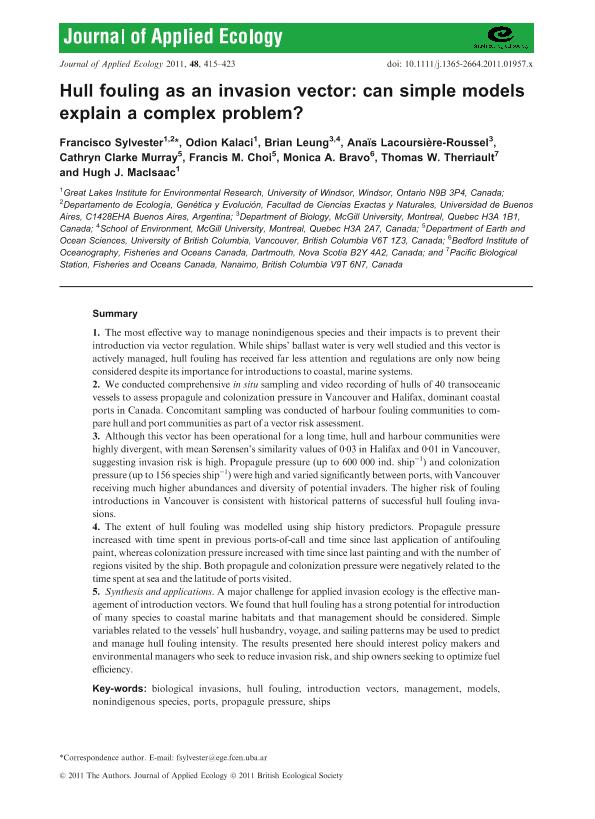Artículo
Hull fouling as an invasion vector: Can simple models explain a complex problem?
Sylvester, Francisco ; Kalaci, Odion; Leung, Brian; Lacoursière Roussel, Anaïs; Murray, Cathryn Clarke; Choi, Francis M.; Bravo, Monica A.; Therriault, Thomas W.; MacIsaac, Hugh J.
; Kalaci, Odion; Leung, Brian; Lacoursière Roussel, Anaïs; Murray, Cathryn Clarke; Choi, Francis M.; Bravo, Monica A.; Therriault, Thomas W.; MacIsaac, Hugh J.
 ; Kalaci, Odion; Leung, Brian; Lacoursière Roussel, Anaïs; Murray, Cathryn Clarke; Choi, Francis M.; Bravo, Monica A.; Therriault, Thomas W.; MacIsaac, Hugh J.
; Kalaci, Odion; Leung, Brian; Lacoursière Roussel, Anaïs; Murray, Cathryn Clarke; Choi, Francis M.; Bravo, Monica A.; Therriault, Thomas W.; MacIsaac, Hugh J.
Fecha de publicación:
04/2011
Editorial:
Wiley Blackwell Publishing, Inc
Revista:
Journal of Applied Ecology
ISSN:
0021-8901
Idioma:
Inglés
Tipo de recurso:
Artículo publicado
Clasificación temática:
Resumen
1. The most effective way to manage nonindigenous species and their impacts is to prevent their introduction via vector regulation. While ships' ballast water is very well studied and this vector is actively managed, hull fouling has received far less attention and regulations are only now being considered despite its importance for introductions to coastal, marine systems. 2. We conducted comprehensive in situ sampling and video recording of hulls of 40 transoceanic vessels to assess propagule and colonization pressure in Vancouver and Halifax, dominant coastal ports in Canada. Concomitant sampling was conducted of harbour fouling communities to compare hull and port communities as part of a vector risk assessment. 3. Although this vector has been operational for a long time, hull and harbour communities were highly divergent, with mean Sørensen's similarity values of 0·03 in Halifax and 0·01 in Vancouver, suggesting invasion risk is high. Propagule pressure (up to 600 000 ind. ship-1) and colonization pressure (up to 156 species ship-1) were high and varied significantly between ports, with Vancouver receiving much higher abundances and diversity of potential invaders. The higher risk of fouling introductions in Vancouver is consistent with historical patterns of successful hull fouling invasions. 4. The extent of hull fouling was modelled using ship history predictors. Propagule pressure increased with time spent in previous ports-of-call and time since last application of antifouling paint, whereas colonization pressure increased with time since last painting and with the number of regions visited by the ship. Both propagule and colonization pressure were negatively related to the time spent at sea and the latitude of ports visited. 5. Synthesis and applications. A major challenge for applied invasion ecology is the effective management of introduction vectors. We found that hull fouling has a strong potential for introduction of many species to coastal marine habitats and that management should be considered. Simple variables related to the vessels' hull husbandry, voyage, and sailing patterns may be used to predict and manage hull fouling intensity. The results presented here should interest policy makers and environmental managers who seek to reduce invasion risk, and ship owners seeking to optimize fuel efficiency.
Archivos asociados
Licencia
Identificadores
Colecciones
Articulos(IEGEBA)
Articulos de INSTITUTO DE ECOLOGIA, GENETICA Y EVOLUCION DE BS. AS
Articulos de INSTITUTO DE ECOLOGIA, GENETICA Y EVOLUCION DE BS. AS
Citación
Sylvester, Francisco; Kalaci, Odion; Leung, Brian; Lacoursière Roussel, Anaïs; Murray, Cathryn Clarke; et al.; Hull fouling as an invasion vector: Can simple models explain a complex problem?; Wiley Blackwell Publishing, Inc; Journal of Applied Ecology; 48; 2; 4-2011; 415-423
Compartir
Altmétricas



